CS & IT 2011 Day 2
Wow! The day started off with a bang. Doug Rushkoff, who wrote Program or Be Programmed: Ten Commands for a Digital Age , was the opening keynote. Agree or disagree with what he says he was a dynamic speaker. I think most of us would have been ok if he had run long. One of the things he said is that when it comes to teaching programming it is all children left behind. It’s a scary thought to many of us. The talk was recorded and when it becomes available online I will be sure to link to it.
 Douglas Rushkoff presenting the CS&IT keynote
Douglas Rushkoff presenting the CS&IT keynote
The first session I attended was by Bootstrap: Algebraic Programming for the Middle School Classroom by Emmanuel Schanzer. Emmanuel is a great speaker – high energy, clear and concise and his enthusiasm really comes out. His Bootstrap program really looks exciting for introducing algebraic programming to middle school students. His curriculum is based on functional programming languages like We Scheme but a lot of his pedagogy is applicable to procedural languages as well.
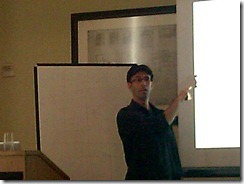
![]() Emmanuel Schanzer from Bootstrap
Emmanuel Schanzer from Bootstrap
After the first break I attended Peggy Fisher and Pat Phillips’ session on web development with Expression Web. Peggy is yet another teacher whose enthusiasm for teaching is infectious. You can get a lot of the resources she talked about at the Expression Education Page. The curriculum is concepts based rather than tools based.
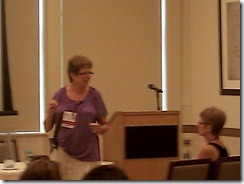 Peggy Fisher (Standing) and Pat Phillips (seated)
Peggy Fisher (Standing) and Pat Phillips (seated)
I had to miss the Quick Start to Small Basic with Damian DeMarco because it was at the same time as Peggy and Pat and I had to introduce them because I am on the program committee. I did sneak in and get a picture of him in action though.
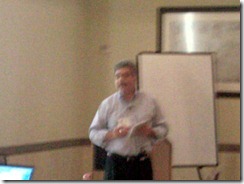 Damian DeMarco presenting on Small Basic
Damian DeMarco presenting on Small Basic
There seems to be a lot of interest in Small Basic these days. A lot of people are using it and looking to see how it fits in their curriculum.
Mark Hindsbo (VP of Developer and Platform Evangelism at Microsoft and my boss’ boss’ boss) came to CS & IT today at lunch time. He spent some time talking to individual teachers as well as gave some brief remarks.
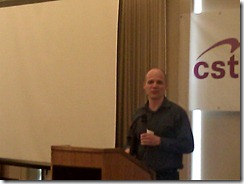 Mark Hindsbo (on Twitter at @MHindsbo)
Mark Hindsbo (on Twitter at @MHindsbo)
Mark really believes that we need to do more to reach students with computer science at a younger age. As such he has been quite supportive on my work and the work of others involved in K12 CS outreach. It was great to have him make that support explicit by attending CS & IT especially as his schedule is totally packed with the Imagine Cup finals going on this week elsewhere in New York.
After lunch I attended Game On: Three Years of Game Development at the Secondary Level Using Visual Studio with Rodrigo Anadon
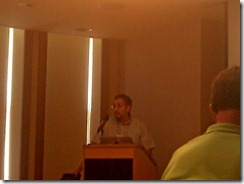 Rodrigo Anadon presenting on Visual Studio, Visual Basic and the rest of his game related curriculum
Rodrigo Anadon presenting on Visual Studio, Visual Basic and the rest of his game related curriculum
It was interesting that he does a lot of console applications along with the GUI programming. He spent a lot of time looking for sample code for tic tac toe to make sure he would know if his students just grabbed solutions from the web. Rodrigo uses the MSDN Academic Alliance to get Visual Studio for his classroom and students. He also uses some open source software and Linux for some things.
Then is was my turn to co-present Excite Students About Programming in a Fun, Easy and Free way! Use Kodu From Microsoft® Fuse Labs®. with Peggy Fisher. I love Kodu for younger kids but even high school kids love it. Honestly Peggy does most of the talking. It’s more important, I think, for teachers to hear from teachers. I’m mostly there for support and to occasionally slow Peggy down when she gets too excited. ![]()
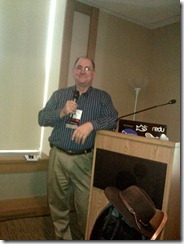 Alfred Thompson presenting on Kodu
Alfred Thompson presenting on Kodu
Peggy and I had a great time presenting. Kodu is one of those things that works best as a demo rather than a straight talk. So we, well Peggy mostly, did a lot of demo.
Closing Keynote SPIRAL: Combining Learning, Play and Exploration by Ken Perlin.
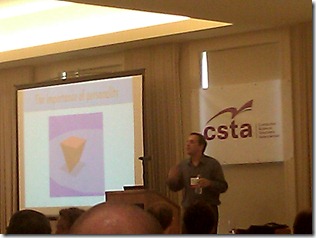 Ken Perlin presenting the closing keynote.
Ken Perlin presenting the closing keynote.
Ken really like the Kinect sensor device as a way to expand the way we interact with the computer. He showed off some of the work that they are doing with it at NYU. I need to find some links to it because it looks really cool.
One day left but I already have a ton of things to think about. So I will be writing some of those thoughts up and posting them over the next week or so. Were you are CS&IT? What do you learn? What was cool? What was bad/not good? I’ve love to hear your feedback.
BTW Doug Peterson was also there and posted his notes and reflections (and better pictures) on his blog.